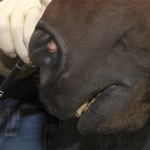Equine Gastric Ulcer Syndrome and Rebound Hyperacidity: What We Know

Horses frequently develop gastric ulcers, which can lead to health and performance concerns. Squamous disease, when ulcers occur in the upper portion of the stomach, develops when the acidic gastric contents splash onto the squamous lining, causing physical damage. One way of treating squamous ulcers is to administer an acid-suppressing medication called omeprazole.
Hydrochloric acid is produced by parietal cells located in the stomach wall. They are stimulated to produce acid through the action of gastrin.
“Gastrin is a hormone produced by gastric G-cells in response to proteins in the gastrointestinal tract. In addition to gastrin, specialized endocrine cells found in the luminal epithelium of the gastric glands, called enterochromaffin-like (ECL) cells, secrete histamine, which stimulates parietal cells to produce and release gastric acid,” explained Kathleen Crandell, Ph.D., a Kentucky Equine Research nutritionist.
Proton pumps help the parietal cells secrete hydrochloric acid into the stomach. Omeprazole is a proton pump inhibitor that diminishes the secretion of acid by the parietal cells, thereby causing an increase in stomach pH, which means that it is less acidic.
When the pH of the stomach is low (acidic), the horse’s body switches on a “negative feedback mechanism” that turns off acid production. This results in decreased production of gastrin, which therefore decreases the signals to the parietal cells to produce acid. When a horse is being treated with omeprazole and the pH of the gastric fluid is more basic, this negative feedback mechanism is switched off.
“As a result, there are high levels of gastrin circulating in the bloodstream. When omeprazole is abruptly discontinued, as is done routinely at the end of the prescribed treatment period, those high levels of gastrin stimulate the parietal cells to instantly begin producing hydrochloric acid,” said Crandell. “This means that ‘rebound hyperacidity’ occurs in the first few days following omeprazole discontinuation.”
Rebound hyperacidity is detrimental and appears to (at least temporarily) defeat the purpose of treating horses with omeprazole to decrease the acidity of the stomach.
“This is why it is so important to make management changes in the horse’s daily routines in addition to simply giving them omeprazole,” emphasized Crandell.
One example of an important management change includes ensuring a horse has access to free-choice forage, specifically hay or other long-stem forage that forms a mat in the stomach that serves as a physical barrier by floating on the top of gastric liquid. This mat helps stop the acidic gastric juice from splashing on the squamous lining of the stomach.
“ReSolvin EQ, a long-chain polyunsaturated fatty acid (PUFA) supplement, can protect horses from the adverse effects of gastric ulcers. Studies conducted at Kentucky Equine Research found long-chain PUFA supplementation with increased circulating levels of GLA, EPA, DHA, DGLA, and AA, was positively associated with the prevention or resolution of severe squamous gastric ulceration,” Crandell said.
Researchers are actively conducting studies investigating high gastrin levels that result due to interruption of the negative feedback loop.* With the hope of making this research easier, they explored whether two commercially available “bench top” gastrin tests could be used rather than sending samples to a commercial laboratory that requires radioactive molecules to perform the test.
Side-by-side comparison of the two bench top tests to the radioimmunoassay, however, found results were highly variable and had unacceptable correlation to the radioimmunoassay. The researchers did not recommend using these nonradioisotope tests when exploring gastrin levels and rebound hypergastrinemia and hyperacidity in horses.
*Vokes, J.R., K.R. Gedye, A.L. Lovett, M.C. de Kantzow, R. Shan, C.M. Steel, and B.W. Sykes. 2024. Evaluation of two commercial ELISA kits for measuring equine serum gastrin compared to radioimmunoassay. Animals (Basel) 14(20):2937.








